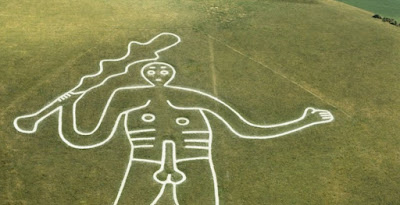Talking of gods, and because I'm always partial to a bit of psychogeography, here's some news about the Cerne Abbas giant and his huge club. To save you reading the whole piece, the chalk outline version is that he began as an effigy of Hercules to rally the troops of Alfred the Great against those pesky Vikings.
I realize it's fashionable these days to think of Vikings as peaceable multicultural traders, but that wasn't quite how the 9th century Anglo-Saxons thought of them. What's interesting is that Hercules was an ambiguous folk hero to the people of Wessex, who you'd think might have been sniffy about pagan demi-gods. But by the 11th century the local monks decided the big lad was actually their patron saint Eadwold. (Saints back then were obviously a bit more priapic and a bit less pudibund.)
The Giant shows another side of his nature in one of the Royal Mythological Society posts from Mirabilis: Year of Wonders. And if you're looking for a way to work chalk giants into a roleplaying game, take a look at my scenario "Wayland's Smithy" for Legend (the world of Dragon Warriors).



The Sistine chapel of its day? A massive graffiti god with veins of chalk...I wonder how many more such titans lie hidden beneath the grass, forgotten by us, but not by the hillsides that bear their ghostly silhouettes deep within the soil where plant-roots dream?
ReplyDeleteWhen I walk on Crosby beach, near my home, and look at the line of Anthony Gormley's 'Iron Men' - naked effigies which surely share artistic DNA with the Cerne Abbas giant - I sometimes wonder what archaeologists of the far future would make of them, if a dark age intervened between now and then. Were these the religious icons of a people that worshipped the sea, set up in propitiation of the waves (in place of human sacrifice), or watchers waiting for the boats coming from the undying lands of the west, beyond the sunset sea? Silent sentinels of the journey...
You've reminded me, John, of a project from some twenty years ago to create art forms that would universally signal a place to be shunned. The idea was to surround nuclear waste dumps with some kind of imagery that would warn off even a post-apocalyptic society with no notion of radiation hazards. I think the eventual conclusion was that there was no universal symbolism that would work. I certainly found the examples the sculptors came up with to be more intriguing than alarming.
Delete